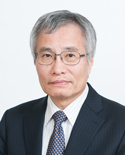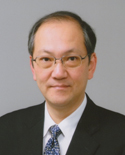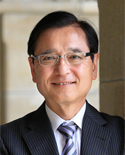Executive Vice President, The University of Tokyo
Contributing research achivements (i.e., seeds of innovative technology) created by universities to
society is expected more than ever before.
Wide range of cutting-edge research is carried out at the University of Tokyo on a daily basis.
It can be said that it is our core mission to translate findings from these research to
improve society, not just in Japan but around the world.
Healthcare is important issue for Japan that is experiencing an unprecedented population aging.
Development of pharmaceutical and medical device that remains highly competitive globally
is also one of the pillars of Japanese growth strategy.
The Medical Innovation Intiative aims to foster translational research personnel who
connect basic discovery into clinical application. It also aims to foster industry-academia
collaboration leaders in medical sector.
I have high hopes that alumnae and alumni of this program will expand global network and
promote medical innovation created by Japan.

Kazuo Hotate
Executive Vice President, The University of Tokyo
Director, The University of Tokyo Hospital
Although medical technology is advancing rapidly, there remains many challenges
that must be addressed.
We believe that one of the overarching mission of the University of Tokyo is to reveal the root causes of disease
through basic research and develop advanced medical treatment based on such research findings.
Addressing diverse health care needs associated with an aging population is also a pressing issue.
The need for medical professionals with management perspective who can assess different needs
in the clinical settings has never been more important than it is today.
Such management skills are essential to provide the best and most appropriate care to patients within a
short period of time, using limited resources available.
There is also strong need for leaders who can anticipate future medical needs and
translate basic research findings into clinical application and ultimately deliver new treatments to patients.
I hope that this program will enable as many users as possible to develop these skills,
and play an active role in clinical settings not only in Japan but also around the world.

Nobuhito Saito
Director, The University of Tokyo Hospital
Project Director, Medical Innovation Initiative
The University of Tokyo
What will Japan and the world look like 20 or 30 years from now? The time will come soon when a person like you, who is accessing this HP will be playing a central role in our society. And the society then should be very different from the current one, which in good or bad ways retains residues of 20th century.
It is certain that those changes will happen in the medical area as well. The values that have been relevant under the social structure and environment of the last century are forced to change now. This turnover of the values happens because of two very distinct moves of recent years. Firstly, it comes from ever heightening medical expenditure derived by declining birthrate and an aging population, and social structure changes caused by population concentration in urban areas and the consequential impoverishment of rural communities. Secondly, it comes from advances in medical science and technology, coupled with the changes in the structure of the healthcare delivery system and expansion of the remit of healthcare business that healthcare providers offer based on their insights of the commercial opportunities. These complicated factors interact with each other and will form a unique shape of medical society in the coming years. In addition, one cannot forget about the new horizon that the emergence of medical big data, ICT and AI will bring us, as well as the implementation of precision medicine using genomics and phenomics data. All of these things will make the future of medicine a very different one from what we have now.
However, contrary to these emerging trends, and their transformative innovation, we still rely on a legacy medical education system that is rooted in the twentieth century. While a solid education system is important for acquiring the fundamentals, there is a pedagogic imperative to also construct an education and nurturing system that brings futuristic medical features into perspective. A future-focused education platform is increasingly a pressing issue for Japan. This is central to the Medical Innovation Initiative. We believe it is our mission to prepare and empower future leaders through our education programmes and curriculum that were created to reflect the paradigm shift in science and medicine decades ahead. With this singular objective we have developed this program.
I hope students will actively participate in this core program, stimulate their imagination and spread their wings around our inter-connected world to carve out new paths in the field of medicine.

Masuhiro Kato
Project Director,
Medical Innovation Initiative The University of Tokyo

